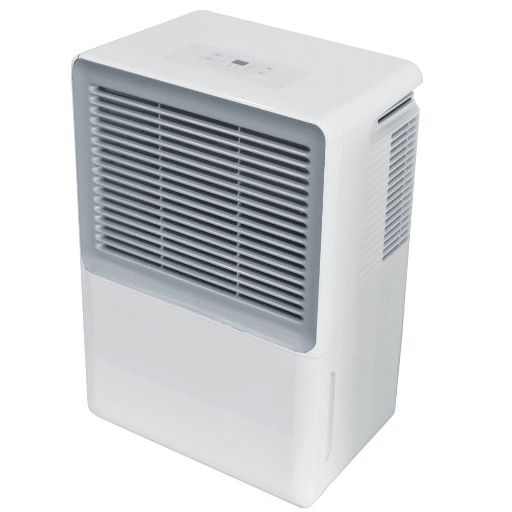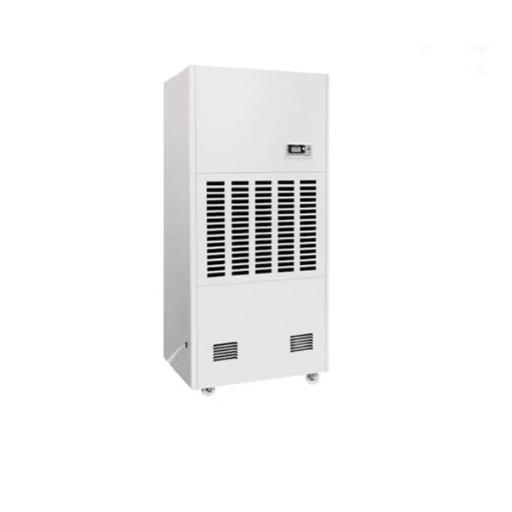The task of keeping a basement at the ideal humidity level is a huge problem particularly in areas prone to dampness or having high humidity. Besides being a discomfort, excess moisture can eventually become a culprit for the buildup of mold, structural damage, and bad air quality among other serious problems. The 70-pint dehumidifier, on the other hand, introduces a powerful and practical approach to combatting the humidity in the basement. This article will provide insights on the reasons behind the 70-pint dehumidifier being the best option for large and moisture-prone spaces.
Understanding Dehumidifiers
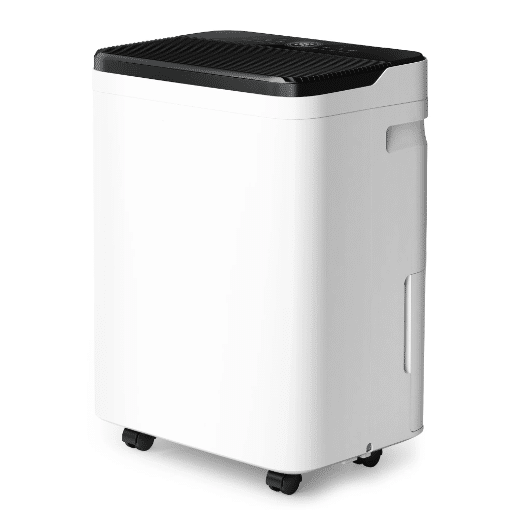
Dehumidifiers are machines that are meant to cut down and keep the humidity in the air at a certain level. They do this by taking in moist air, taking out the water that is over the limit, and putting back the drier air into the room. This method is very effective in locking out the problems caused by excess moisture such as mold growing, unpleasant smells, and damage done to furniture or walls. A 70-pint dehumidifier is very suitable for large rooms as it removes moisture to a great extent daily, thus making it more comfortable and a healthier place to stay.
What is a Dehumidifier?
A dehumidifier is an appliance that helps in significantly lowering and controlling the amount of humidity in the air in a specific area. It is mainly used to enhance the quality of the air and to prevent problems caused by excess moisture. The process through which a dehumidifier works involves the intake of humid air, cooling of the air to remove moisture, and finally the re-introduction of drier air into the environment. Through this method dehumidifiers manage to stop the formation of mold, mildew, etc., as well as the protection of a building from these issues through its drying power.
How Do Dehumidifiers Work?
The Dehumidification Process:
Step 1: Air Intake
A fan brings in air from the surrounding area into the dehumidifier unit.
Step 2: Cooling and Condensation
The air passes over cooled coils, causing moisture to condense into water droplets.
Step 3: Water Collection
Droplets are collected in a tank or disposed of through a drainage pipe.
Step 4: Air Release
The dried air is heated back to room temperature and released back into the space.
Types of Dehumidifiers
| Type | Best For | Key Features |
|---|---|---|
| Refrigerant Dehumidifiers | Hot and humid climates | Chill air to precipitate moisture; best for large moisture removal |
| Desiccant Dehumidifiers | Cold climates | Use silica gel; smaller, quieter, no cooling required |
| Whole-House Dehumidifiers | Entire buildings | Integrated with HVAC; energy-efficient; requires professional installation |
| Portable Dehumidifiers | Single rooms | Easy to move; no installation; versatile placement |
| Smart Dehumidifiers | Tech-savvy users | Wi-Fi enabled; smartphone control; auto-adjustment; energy efficient |
Why Choose a 70 Pint Dehumidifier for Your Basement?
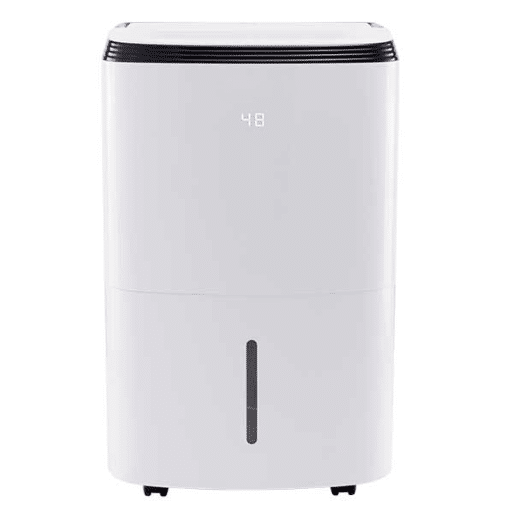
A 70-pint dehumidifier, which is capable of removing up to 70 pints of humidity from the air per day, is recommended for basements because it has such a strong moisture-removing capacity. This is a great solution for big areas or places with lots of humidity. Besides, it can prevent mold and mildew as well as damage to the structure of the building caused by the moisture in the basement.
Benefits of a 70 Pint Capacity
💧 High Moisture Removal
Removes up to 70 pints of water per day, making it ideal for large rooms or extremely damp areas.
🛡️ Mold Prevention
Effectively prevents mold growth by maintaining optimal humidity levels, protecting your health and property.
⚡ Energy Efficient
Modern 70-pint models feature Energy Star certification, consuming less electricity while delivering powerful performance.
🏠 Protects Structure & Furniture
Keeps wooden furniture and building components free from moisture damage, extending their lifespan.
🌬️ Allergen Reduction
Reduces allergens and improves indoor air quality, creating a healthier living environment.
Comparing 70 Pint vs 50 Pint Dehumidifiers
| Feature | 70 Pint Dehumidifier | 50 Pint Dehumidifier |
|---|---|---|
| Moisture Removal | Up to 70 pints per day | Up to 50 pints per day |
| Best For | Large rooms, basements, high-moisture areas | Medium-sized areas, moderate humidity |
| Coverage Area | Up to 2,500+ sq ft | Up to 2,000 sq ft |
| Energy Usage | Higher but efficient with Energy Star models | Lower energy consumption |
| Cost | Higher initial investment | More budget-friendly |
| Ideal Use Case | Flood-prone areas, high humidity basements | Seasonal moisture, smaller spaces |
Ideal Conditions for a 70 Pint Dehumidifier
- Coverage Area: Ideal for spaces up to 2,500 square feet
- Humidity Levels: Most effective when humidity is consistently above 60%
- Best Locations: Large basements, open living rooms, warehouses, crawl spaces
- Climate: Suitable for both hot and cold weather conditions
- Special Applications: Flood-affected areas requiring rapid water extraction
- Environment: Works best in enclosed spaces for continuous operation
Features to Look for in a 70 Pint Dehumidifier
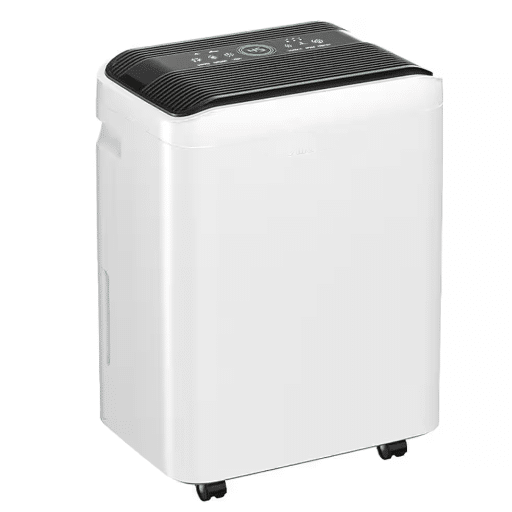
There are a number of important elements to think about when weighing the options of a 70-pint dehumidifier. These features will help ensure you get the best performance and value from your investment.
📊 Adjustable Humidistat
Allows you to set and maintain preferred humidity levels, essential for proper moisture management in different climates.
💦 Large Capacity Tank or Continuous Drain
Minimizes the inconvenience of frequent emptying, especially important in flood-affected or very damp areas.
⭐ Energy Star Certification
Ensures the unit uses less power without compromising performance, reducing electricity bills and environmental impact.
⏰ Programmable Timer
Allows you to schedule operation times for maximum convenience and energy efficiency.
🔄 Auto-Restart After Power Failure
Automatically resumes operation with previous settings after a power outage, ensuring continuous moisture control.
🌬️ Built-in Air Purifier
Provides additional air quality benefits by filtering out dust, allergens, and odors.
Energy Star Certification
Energy Star Certification is an extremely important standard for energy efficiency which is recognized globally and it helps the consumers to pick appliances that use less energy but still do not compromise on their performance. The appliances with this certification not only lower the electricity bills but also the carbon footprints, thus, they are a good choice for the buyers who are concerned about the environment as they are the sustainable choice. Purchasing such products is not only cost-saving in the long run but also is in line with the efforts to fight climate change worldwide.
Continuous Drain Options
The continuous drain options have been no longer emerging but rather becoming a necessity, more so for the convenience and efficiency of dehumidifiers. A continuous drain arrangement disposes of the water through a hose that is connected directly, thus it does away with the necessity of the tanks to be emptied manually often. These systems are very much appreciated by the users who see the need for cutting down on their maintenance efforts but at the same time do not want to compromise on environmental issues.
Smart Features and Humidistats
🤖 Smart Technology Benefits:
- Wi-Fi Connectivity: Control and monitor from anywhere using smartphone apps
- Smart Home Integration: Compatible with Google Assistant and Amazon Alexa
- Automatic Adjustment: Responds to real-time environmental conditions
- Maintenance Alerts: Notifications for filter changes and tank emptying
- Energy Usage Tracking: Monitor consumption for optimal efficiency
- Automatic Shut-off: Prevents overflow and conserves energy
Top 70 Pint Dehumidifiers for Basements

Frigidaire FGAC7044U1
This unit, recognized for its strong dehumidification profile, is connected to Wi-Fi and thus, users can take control of it and monitor its working via a smartphone app. The combination of its energy-saving design and quiet operation makes it a dependable large area basement choice.
hOmeLabs HME020031N
This dehumidifier is the best choice for a user-friendly, heavy-duty device. It has a capacity of up to 70 pints and the option of continuous draining for convenience plus an automatic shut-off feature to safeguard against overflow.
Hisense DH7019KP1WG
Thanks to the digital control and the low-temperature operation, this dehumidifier has vast application in the cold basement areas. Its groundbreaking design also incorporates a washable filter and the use of less energy.
Honeywell TP70AWKN
Rating very high in moisture removal, the Honeywell unit impresses with its smart controls, one of which is the Wi-Fi connectivity and adjustable humidity settings. It has a special place among users because of its durability and security features, inclusive of the thermal overload protection.
Overview of the Aprilaire E070
The Aprilaire E070 is an efficient, small-scale dehumidifier unit explicitly designed for home use, even in basements and crawl spaces. It can remove up to 70 pints of moisture per day which is an appreciable amount for keeping the humidity level in medium-sized rooms under control. The E070 is built to last and comes with a prolonged warranty covering corrosion-resistant coils and sturdy housing. The unit’s energy efficiency is one of its main advantages as it allows users to have dry, fresh air without a proportionate rise in power consumption.
Waykar 70 Pint Dehumidifier
The Waykar 70 Pint Dehumidifier is a powerful device that is made to extract 70 pints of moisture daily, so it can be used in rooms up to 4,500 sq. ft. With its smart control system, the dehumidifier changes its operation according to the humidity levels in the room and thus provides a perfect balance of moisture and saves energy at the same time. The unit’s contemporary and elegant design makes it an excellent fit for different types of interiors, and it comes with a simple-to-use touch panel, a timer for 24 hours, and various drainage options to make it easy to operate.
Other Notable Models
| Model | Capacity | Best For | Key Highlights |
|---|---|---|---|
| Frigidaire High Efficiency | 50 Pints | Large areas | Digital controls, continuous drain, low noise, easy-clean filter |
| hOmeLabs Commercial-Grade | 140 Pints | Basements, warehouses | Digital control panel, integrated handles, solid construction |
| Vremi Compact | 22 Pints | Small to medium spaces | Portable, energy-efficient, auto-shutoff, budget-friendly |
Installation and Maintenance Tips
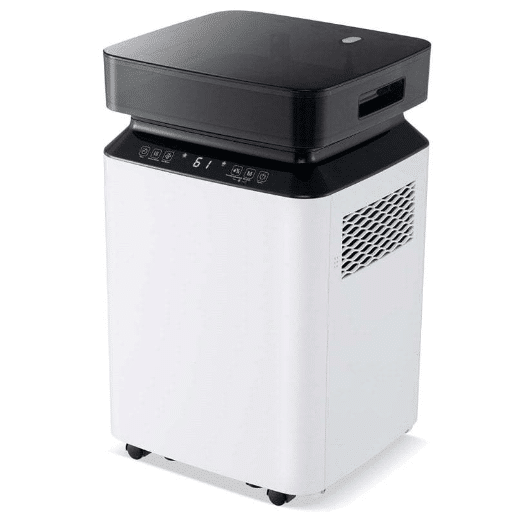
Proper installation and regular maintenance are crucial for maximizing the performance and lifespan of your 70-pint dehumidifier. Follow these best practices to ensure optimal operation.
✅ Essential Installation & Maintenance Guidelines
📍 Optimal Placement
To achieve the best air circulation the dehumidifier should be positioned in the central part of the room. Moreover, it has to be surrounded by at least a foot of open space on all sides to allow proper airflow and to support the efficient operation of the device.
🎚️ Correct Humidity Setting
Setting the dehumidifier to 30-50% will result in the best operation and performance. For basements or areas that are very likely to get wet, making the setting close to 40% will not only prevent mold growth but will also be economical in terms of energy use.
🧼 Clean the Washable Filter Regularly
Cleaning of the air filter should be done every 2-3 weeks. This will help to keep efficiency and airflow at their maximum. Lukewarm water mixed with a mild detergent should be used to wash out the filter and to get rid of the dust and other particles, thereby guaranteeing the good operation of the filtration system.
💧 Empty the Water Tank Frequently
The water tank will need to be emptied either daily or every few days only, depending on the level of humidity in the air. As an alternative, a continuous drain hose can be connected that will take care of the draining process automatically, thus avoiding overflows.
🔧 Inspect and Clean the Coils Annually
At a minimum, once every year, inspect the condenser coils for dirt or frost accumulation. With a soft brush, remove any dust or debris, and keep the unit unplugged while cleaning to avoid damage or electrical hazards.
Proper Placement in the Basement
The placement of a dehumidifier in your basement directly affects its ability to do its work. While the general placement guidelines and search data provide very good and clear indications, it is still good practice to position the dehumidifier in the center of the room or in an open space that provides the best air circulation pattern.
⚠️ Placement Tips:
- Avoid placing directly against walls or near large furniture
- Position near main moisture sources (sump pumps, leaks) for better control
- Ensure unit sits on an even surface to prevent operational problems
- Keep away from heaters or extremely cold areas to prevent inefficiency or frost
- Maintain at least 12 inches of clearance on all sides
- Choose central location for optimal air circulation throughout the space
Regular Maintenance Practices
🔄 Clean the Filter Often
Almost all dehumidifiers are fitted with air filters that trap dust and other particles. Depending on the conditions and use, these filters should be either cleaned or replaced once every 2 to 3 weeks. A filter with clogged pores can greatly reduce the unit’s efficiency and cause it to work harder.
🧽 Examine and Clean the Coils
Moisture and dirt can build up on the evaporator and condenser coils of the unit over time, thus causing freezing or cutting off airflow. It is suggested to clean these coils with a soft cloth and a non-abrasive cleaner every few months.
🧴 Dispose of and Sanitize the Water Tank
To stop the growth of mold and bacteria, the water collection tank should be emptied daily. Moreover, sanitizing the tank weekly with either a gentle detergent or a vinegar solution will keep the tank clean and any indoor air quality issues at bay.
🚰 Inspect the Drain Outlet or Hose
If the unit has a continuous drain feature, then check the hose for any blockages or leaks. Ensure that the drainage system is operating correctly so that there are no water overflow or damage problems.
📊 Test the Hygrometer
The hygrometer sensor that comes with the device measures the humidity in the area. Occasionally, recalibrating or testing its accuracy is required to be sure that it is giving correct readings which result in the efficient operation of the unit.
How to Use Drainage Systems Effectively
The drainage systems are crucial not only for keeping the moisture levels under control but also for protecting the buildings and structures from water-related damages. The first thing to do for the efficient use of drainage systems is to check and comply that all of their parts like pipes, hoses, or channels which are the main drainage forms, are properly cleaned and are free of any kind of obstruction. Regular maintenance that includes clearing and checking the installations for leaks should be done in order to keep the perfect function going on.
💡 Drainage System Tips:
- Adjust slope/gradient of drainage lines for unobstructed water flow
- Use quality materials like PVC or stainless steel for durability
- Properly seal all joints to minimize corrosion and leak risks
- Consider smart drainage systems with sensors for real-time monitoring
- Consult experts for complex setups or heavy water flow management
References
-
Choosing the Right Commercial Grade Dehumidifier (University of Illinois Chicago)
This guide explains the importance of selecting the right dehumidifier size, including 70-pint models for large basements.
Read more here -
Indoor Air Quality and Moisture Control (North Dakota State University)
This document highlights the use of dehumidifiers to manage humidity in basements, especially in humid conditions.
Read more here -
Resources for Your Flooded Home (University of Wisconsin Extension)
This resource recommends dehumidifiers as an effective tool for moisture control in flood-affected basements.
Read more here
Frequently Asked Questions (FAQ)
What 70 pint dehumidifier is used for basement?
A 70-pint dehumidifier for basement use is a powerful air drier that is intended for the extraction of humidity from the air of wet basements, and its capacity is the removal of up to 70 pints of water vapor in a day, thus helping to eliminate the risks of mold, mildew, and other forms of water-related damage in your house.
In what way does a 70-pint dehumidifier differ from a 50-pint dehumidifier?
A 70 pint dehumidifier is able to cope with larger spaces or higher humidity levels while a 50-pint dehumidifier is limited to smaller areas or lower humidity levels. If your cellar suffers from serious moisture problems or is substantially bigger than usual, a 70-pint dehumidifier is going to be the most efficient one in removing moisture.
Is it possible to use a 70-pint dehumidifier with a pump for draining continuously?
Definitely, a lot of 70-pint dehumidifiers have an integrated pump and a drain hose so they can provide the continuous drainage, which would be a situation in which you would not have to empty a water tank manually anymore. Therefore, easier maintenance comes with, especially in places such as basements or crawl spaces where it is quite hard to access.
What are the most important features of a good dehumidifier for a basement?
If you are going to buy a powerful dehumidifier for your basement, features such as multiple fan speeds, digital display, auto shut-off, and humidistat should be on your list. These features are not only for the performance but also for user friendliness, thus providing the best moisture control.
Should the energy star dehumidifier be considered as worth the price?
An energy star dehumidifier works with less power than the standard dehumidifiers, this would eventually lead to a reduction in your electricity bills. Always look for the energy star certified units for both the environment and your wallet.
What is the right way of installing a dehumidifier in my basement?
For the dehumidifier installation in the basement, it should be put in a central area away from walls and other things that may hinder airflow for proper functioning. And also make the unit level and if your model allows it, consider using a garden hose for continuous drainage.
What reason are there for using a dehumidifier with a pump in a crawl space?
Using a dehumidifier with a pump in the crawlspace is very beneficial in controlling the moisture levels, which would wards off the musty smells and damage due to water. The pump facility contributes to easy ejection of the water which is best suited for places that are hard to reach.
What is the operation of the humidistat feature in dehumidifiers?
The humidistat feature of a dehumidifier keeps an eye on the humidity levels around your basement. Once the humidity level crosses a predetermined limit, the dehumidifier gets into action and starts removing the excess moisture, thereby making the atmosphere comfortable.
Is combining a smart dehumidifier with Alexa and Google possible?
Many tech-savvy dehumidifiers today are such that they work with smart home systems like Alexa and Google. Thus, there would not be any limitation regarding the controlling of the unit, setting of schedules, and ease of monitoring humidity levels, etc. and all this can be done via your mobile phone.

